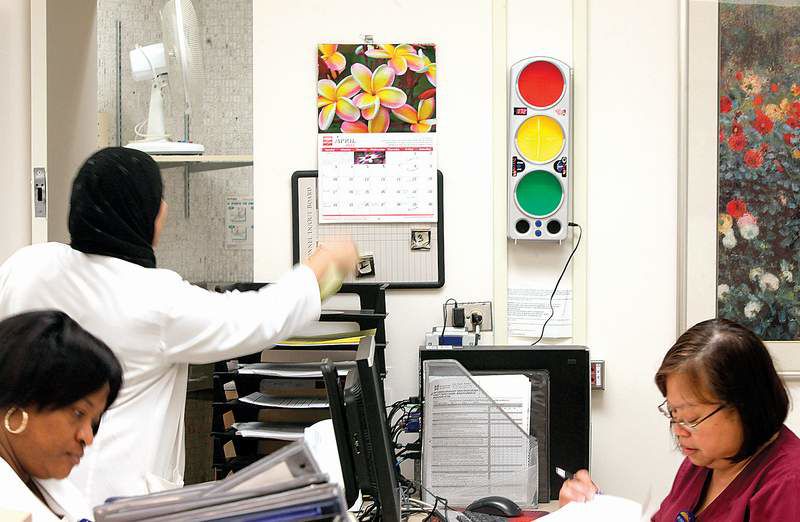Hospitals drowning in noise
Published 5:00 am Thursday, May 19, 2011

- Saint Joseph Hospital registered nurses talk quietly underneath the Yakker Tracker, which looks like a stoplight. The Yakker Tracker keeps a tab on noise levels on the floor.
CHICAGO — At 3:15 p.m. on a weekday, the busy eighth floor of Chicago’s Saint Joseph Hospital is buzzing with noise. Alarms beep incessantly. The elevator dings each time the doors open. During the shift change, the “cocktail effect” kicks in; people talk louder, straining to be heard over the hubbub.
“When I get home at midnight, I can still hear it (in) my head,” nurse Pedro Arreza said, pointing to the electronic monitors. “But it comes with the territory.”
Health care is noisier than ever. Worldwide, the sound levels inside hospitals average 72 decibels during the day and 60 decibels at night, far exceeding the standard of 40 decibels or less, set by the World Health Organization.
The racket is generated by obvious bedfellows: human beings and technology. But the clamor of modern medicine can harm both patients and staff, a growing body of research on noise and health suggests. Unwanted sound wrecks sleep, raises stress levels, induces medical mistakes and contributes to alarm fatigue, which occurs when monitors shriek so often they are ignored or turned off, causing safety issues.
In response to concerns, hospitals throughout Illinois and the U.S. are launching “quiet campaigns” that include eliminating intercom paging, replacing metal trash cans, installing sound-absorbing flooring and paneling, and dimming lights at night to remind staff to keep their voices down.
Northwestern’s Prentice Women’s Hospital was designed with multiple smaller nurses’ stations rather than one central one to enhance privacy and reduce noise. In the neonatal intensive care unit at the University of Chicago, signs designed to protect babies’ underdeveloped nervous systems say: “Did you know …? Tapping on the top of an isolette (incubator) is equivalent to the sounds of heavy traffic during rush hour!”
Helping health officials rethink hospital safety and design is the Healthcare Acoustics Research Team, an unusual collaboration of experts with experience in acoustics, engineering, architecture and psychology and medicine.
Right now, “there simply aren’t enough companies manufacturing materials that absorb sound and are appropriate for use in hospitals,” said Ilene Busch-Vishniac, a HART team member and co-author of an important Johns Hopkins study that showed day and nighttime sound levels have risen significantly in hospitals since 1960. “So what is available is expensive.”
Redesigning hospitals is costly as well. “We don’t know what’s best,” said Abram Walton, an assistant professor of industrial technology at Purdue University, who is conducting a pilot study using a noise sensor tied to the lighting systems in Midwestern hospitals. “Closed rooms haven’t been shown empirically to unequivocally reduce noise.”
Like libraries, hospitals used to be considered quiet zones. In her 1859 book “Notes on Nursing,” Florence Nightingale railed against unnecessary noise, calling it “the most cruel absence of care.”
But the information age ushered in alarms, motorized beds, monitors, more alarms, automatic hand sanitizer machines, high-powered bone-cutting tools and even more alarms. In older buildings, one of the largest noise generators of all can be the air-handling system. Even environmental factors — such as a lack of trees on hospital grounds and power generators located nearby — can contribute to the din.
Hospitals are also highly reverberant spaces “that contain the full spectrum of humanity, usually at their most vulnerable,” said Diana Pope, a nursing research scientist for the Department of Veterans Affairs at the Portland Medical Center and another HART researcher. The buildings feature hard, easy to clean surfaces such as tile floors. Porous or fuzzy materials are rarely used to absorb energy or deaden space in healthcare settings because they can harbor microorganisms.
Noise pollution
Today noise — even more than hospital food — is one of the top hospital complaints.
Patients exposed to the loudest sounds can lose up to two hours of sleep each night, according to University of Chicago researchers who studied how noise affects the elderly. Sleep deprivation can trigger a host of health problems, including high blood pressure and high blood sugar, fatigue and mood changes.
“Hospital noises levels are far from acceptable, with maximums exceeding the noise level of a chainsaw,” concluded study co-authors Vineet Arora and Jordan Yoder.
Studies also report that noise in hospitals increases heart rates, blood pressure, respiratory rates and cortisol levels. People in noisy recovery rooms requested more pain medication. Pre-term infants, perhaps the most sensitive population, are at increased risk for hearing loss, abnormal brain and sensory development and speech and language problems when exposed to prolonged and excessive noise.
Aiming for quiet
Nevertheless, hospitals are doing what they can to turn down the sound. At Rush University Medical Center, a “silent” patient call button system has reduced intercom pages. Rush’s new hospital, scheduled to open in 2012, is trying to reduce noise by 90 percent from its current operation, said Mick Zdeblick, Rush’s vice president of campus transformation.
The new patient care hallways will be carpeted, backed by a strong spot-maintenance cleaning program, said Zdeblick. In off hours, lights will be dimmed to encourage softer voices in the hallway. The building’s air flow has been designed to be more quiet. Committees are even looking at hanging more sound-absorbing artwork in the hallways, such as a canvas without glass, or decorative cloth reliefs.
Many hospitals, including Swedish Covenant and Resurrection Health Care’s Saint Joseph, have installed Yacker Trackers, a kitschy sound meter that looks like a stoplight and flashes red when it gets too noisy.
Marketed for school classrooms, the Yacker Tracker is hardly a scientific instrument. At St. Joe’s, it’s positioned above an 8th floor nurses station because an outlet was available.. And though it had been in use for less than two weeks, on a recent visit its novelty and effectiveness seem to have worn off.
Between 2 and 3:30 p.m. on a Tuesday, the device hit red 301 times. Each time, much to the staff’s annoyance, a low-pitched siren went off, adding to the din.
Still, nurse Arreza said it was a good reminder that patients need rest. And every so often, he lightens the mood by walking up to the Yacker Tracker and laughing at it, just to see what will happen.
‘Alarm fatigue’
“Alarm fatigue,” or the failure of medical staff to respond to incessantly beeping devices, is one of the top five conditions creating safety issues in hospitals, according to the national organization that accredits the facilities.
“They’re constantly going off, and studies suggest the vast majority of time no action is taken,” said Ilene Busch-Vischniac, McMaster University provost and a noise researcher. “People don’t pay attention to alarms; they exist as much for legal liability reasons as much as for actually doing anything for patients.”
Critical alarms can go off if a patient simply moves or gets up to use the bathroom. They may beep when one of five heart monitor leads comes off, even if the device still works. “Certain alarms we know aren’t critical so we don’t rush,” said Ana Garcia, manager for telemetry at Resurrection Health Care’s Saint Joseph Hospital. “I know some nurses do get fed up with them. You just have to adjust to their rhythm.”






